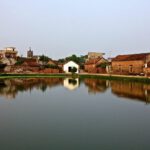Cat Cat Village
Location: San Sa Ho Commune, Sa Pa District, Lao Cai Province, 2km from Sa Pa Townlet. Characteristics: This is an age-old village of Mong ethnic people. This place remains unique customs and practices of local inhabitants. ◊ Traditional Crafts Visitors to Cat Cat have an opportunity to admire a lively and colourful picture. That is the image of […]
Location: San Sa Ho Commune, Sa Pa District, Lao Cai Province, 2km from Sa Pa Townlet. Characteristics: This is an age-old village of Mong ethnic people. This place remains unique customs and practices of local inhabitants.
◊ Traditional Crafts
Visitors to Cat Cat have an opportunity to admire a lively and colourful picture. That is the image of young women sitting by looms with colourful pieces of brocade decorated with designs of flowers and birds. When these pieces of brocade are finished, they are dyed and embroidered with beautiful designs. A noteworthy is that Mong women use plants and leaves to dye these brocade fabrics. And then they roll a round and smooth section of wood covered with wax on fabrics to polish them, making their colours durable. In addition to the brocade weaving craft, many residents in Cat Cat are good at manipulating gold and silver jewelry. Their products are fairly sophisticated, especially jewelry for women.
◊ Unique Custom of “Pulling Wife”
Visitors to Cat Cat are most attracted by its unique customs, including the custom of “pulling wife”. A man can ask his friends to lure a girl he likes to his house and keeps her there in three days. During these days, if the girl agrees to become his wife, a wedding will be held. However, the girl can happily go home after three days if she does not like him.
◊ Traditional Houses of Mong People
Traditional houses of Mong people in Cat Cat have three rooms with three doors and covered with pomu wood roof. In the house there are three columns that stand in round or square stones. The walls are made from sawn timber. The main door is always closed and only opens when people in the house organize important events. Altar, inlaid floor containing food, places for sleeping, kitchen and receiving guests are indispensable parts of the houses.




